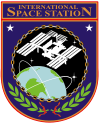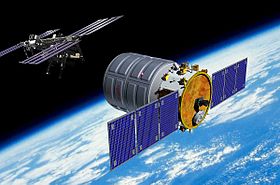- Cygnus (spacecraft)
-
Cygnus spacecraft Description Role: Under development
To be used to supply the International Space Station because of the retirement of the Space ShuttleCrew: 0 Carrier Rocket: Taurus II Dimensions Height:[1] 3.66 m /4.86 m 12.0 ft / 15.88 ft Diameter:[1] 3.07 m /3.07 m 10.07 ft / 10.07 ft Weight (dry):[1] 1,500 kg/ 1,800 kg Volume:[2] 18.9 m3/ 26.2 m3 Delivered Payload:[2] 2,000 kg/ 2,700 kg 4,400 lb/ 5,950 lb Disposal Payload:[3] 1,200 kg 2,600 lb Performance Endurance: Yet to be specified The Cygnus spacecraft is an unmanned resupply spacecraft being developed by Orbital Sciences Corporation and Thales Alenia Space as part of NASA's COTS project. It is designed to transport supplies to the International Space Station (ISS) after the retirement of the Space Shuttle. Since August 2000 unmanned ISS resupply missions have been regularly flown by Russian Progress spacecraft, as well as by two flights of the European Automated Transfer Vehicle and two flights of the Japanese H-II Transfer Vehicle. With the Cygnus spacecraft, NASA seeks to increase its partnerships with domestic commercial aviation and aeronautics industry.[4]
Contents
Development
With Rocketplane Kistler unable to meet funding obligations for its K-1 launch vehicle under the terms of the COTS agreement, NASA decided on October 18, 2007 to terminate its contract with Rocketplane Kistler and re-award its contract after a competition.[5] On February 19, 2008 NASA announced that it had chosen Orbital Sciences as the new winner.[6] On December 23, 2008, NASA awarded Orbital Sciences a $1.9 billion contract under the Commercial Resupply Services plan. Under this contract, Orbital Sciences will deliver up to 20 tons of cargo to the ISS through 2016 in eight Cygnus spacecraft flights.[4]
By April 2010 Orbital had displayed a full-scale model of the Cygnus cargo delivery spacecraft at the National Space Symposium (NSS) in Colorado Springs, CO.[7]
The first Cygnus demonstration flight was originally expected in late 2010, launched by a Taurus II rocket.[8] This has now been postponed to December 2011.[9]
Design
The Cygnus spacecraft consists of two basic components: the service module and the cargo module. The service module is based on Orbital's STAR spacecraft bus as well as components from the development of the Dawn spacecraft. It is currently expected to have a gross mass of 1,800 kg with propulsion provided by thrusters using the hypergolic propellants hydrazine and nitrogen tetroxide and is capable of producing up to 4 kW of electrical power via two gallium arsenide solar arrrays.[10] On November 12, 2009, Dutch Space announced it will provide solar arrays for nine Cygnus spacecraft under a contract valued at more than $35 million.[11]
There are two types of cargo modules slated for use with the spacecraft. The first type is a pressurized cargo module based on the Italian-built Multi-Purpose Logistics Module. This version is expected to have a gross mass of 3,500 kg, a payload mass of 2,000 kg and a total pressurized volume of 18.7 m³. The second type is based on a variant of NASA's ExPRESS Logistics Carrier. This variant will also have a gross mass of 3,500 kg with an expected payload mass of 2,000 kg, depending on the configuration being used, and an expected total cargo volume of 18.1 m³. The spacecraft will dock with the International Space Station by maneuvering close to the space station where the Canadarm2 robotic arm will grapple the spacecraft and attach it to a Common Berthing Mechanism on the Harmony module in a similar fashion to the Japanese H-II Transfer Vehicle.[10] Neither cargo module provides return capability but modules can be loaded with obsolete equipment and trash for destructive reentry similar to Russian Progress modules.
A Cygnus variant with a robotic arm is being considered. Such a variant would be a space tug suitable for supporting the International Space Station, other space stations and propellant depots.[12]
See also
- Unmanned resupply spacecraft - descriptions of other similar vehicles:
- Automated Transfer Vehicle - a similar cargo vehicle developed by European Space Agency, it is currently in use re-supplying the International space station (ISS). Flight and docking is automatic.
- Dragon Cargo spacecraft - a similar cargo vehicle in development, also capable of returning 3000 kg of cargo to Earth,[13] developed by Space Exploration Technologies
- H-II Transfer Vehicle - a similar cargo vehicle developed by Japan Aerospace Exploration Agency, it is currently in use. Flight is automatic, it is manually captured by an ISS robotic arm and berthed to the station.
- Progress spacecraft - a similar cargo vehicle developed by Russian Federal Space Agency it is currently in use. As of March 2011 it has completed 41 resupply missions to the ISS. Progress flight and docking is fully automatic, with mission control and ISS crew having a normally supervisory role only.
References
- ^ a b c "Thales Alenia Space — Cygnus". Thalesaleniaspace-issmodules.com. http://www.thalesaleniaspace-issmodules.com/cygnus. Retrieved 2011-03-01.
- ^ a b "Cygnus Fact Sheet - 2010" (PDF). http://www.orbital.com/NewsInfo/Publications/Cygnus_fact.pdf. Retrieved 2011-03-01.
- ^ "Orbital Science COTS Program". Orbital.com. http://www.orbital.com/HumanSpaceExplorationSystems/COTS/#. Retrieved 2011-03-01.
- ^ a b "NASA Taps SpaceX, Orbital Sciences to Haul Cargo to Space Station". Space.com. 2008-12-23. http://www.space.com/news/081223-nasa-spacestation-cargo-contract.html. Retrieved 2011-03-01.
- ^ "Time Runs out for RpK; New COTS Competition Starts Immediately". Space.com. 2007-10-19. http://www.space.com/news/071019-rocketplane-pulledplug.html. Retrieved 2011-03-01.
- ^ NASASpaceflight.com - Orbital beat a dozen competitors to win NASA COTS contract[dead link]
- ^ "Orbital Unveils Full Scale Cygnus Model". http://www.orbital.com/CargoResupplyServices/.
- ^ "Orbital Sciences To Build Taurus II". AviationWeek.com. http://www.aviationweek.com/aw/generic/story_channel.jsp?channel=space&id=news/Tauras022008.xml. Retrieved 2011-03-01.
- ^ "First Cygnus Flight to ISS Set for December". http://www.parabolicarc.com/2011/01/06/cygnus-flight-iss-set-december/.
- ^ a b "Cygnus Spacecraft factsheet at Orbital.com" (PDF). http://www.orbital.com/NewsInfo/Publications/Cygnus_fact.pdf. Retrieved 2011-03-01.
- ^ Peter B. de Selding (2009-11-12). "Dutch Space to Build Solar Arrays for Orbital’s Cygnus Cargo Tug". Space News. http://www.spacenews.com/contracts/091112-dutch-space-build-solar-arrays--cygnus.html.
- ^ "Cygnus update". http://forum.nasaspaceflight.com/index.php?topic=21179.0.
- ^ Dragonlab datasheet, v.2.1, 2009-09-18. accessed 2011-01-02.
External links
Unmanned resupply spacecraft Historic TKS
Current Automated Transfer Vehicle • H-II Transfer Vehicle • ProgressIn development Cygnus • Dragon (also manned)Cancelled Kistler K-1Components of the International Space Station Overview Assembly · US Orbital Segment · Russian Orbital Segment · Expeditions · Spacewalks · ISS Program · Scientific Research · Major Incidents
Major components
in orbitZarya (Functional Cargo Block) · Zvezda (Service Module) · Unity (Node 1) · Harmony (Node 2) · Tranquility (Node 3) · Destiny (Laboratory) · Columbus (Laboratory) · Kibō (PM, ELM-PS, EF) · Quest (Airlock) · Pirs (Airlock / Docking Module) · Rassvet (MRM 1) · Poisk (MRM 2) · Leonardo (PMM) · Cupola · Integrated Truss Structure (ITS)Subsystems
in orbitFlight-ready hardware
with no launch planScheduled for launch
by ProtonProposed module Cancelled Support vehicles Current: Soyuz · Progress · Automated Transfer Vehicle (ATV) · H-II Transfer Vehicle (HTV)
Future: Dragon · Cygnus · Orion · Rus · CST-100
Former: Space ShuttleMission control centers  Book:International Space Station ·
Book:International Space Station ·  Category:International Space Station ·
Category:International Space Station ·  Portal:SpaceflightCategories:
Portal:SpaceflightCategories:- Supply vehicles for the International Space Station
- Unmanned resupply spacecraft
- Proposed spacecraft
- Unmanned resupply spacecraft - descriptions of other similar vehicles:
Wikimedia Foundation. 2010.

